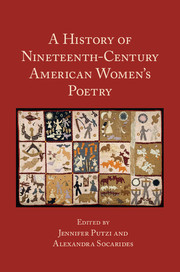Book contents
- Frontmatter
- Contents
- List of Illustrations
- List of Contributors
- Acknowledgments
- Introduction: Making History: Thinking about Nineteenth-Century American Women's Poetry
- PART I 1800–1840, AMERICAN POESIS AND THE NATIONAL IMAGINARY
- PART II 1840–1865, UNIONS AND DISUNIONS
- PART III 1865–1900, EXPERIMENT AND EXPANSION
- 17 Women Poets and American Literary Realism
- 18 Verse Forms
- 19 Braided Relations: Toward a History of Nineteenth-Century American Indian Women's Poetry
- 20 Frances Harper and the Poetry of Reconstruction
- 21 “hear the bird”: Sarah Piatt and the Dramatic Monologue
- 22 Women Writers and the Hymn
- 23 Women Poets, Child Readers
- 24 Emma Lazarus Transnational
- 25 The Creation of Emily Dickinson and the Study of Nineteenth-Century American Women's Poetry
- Suggested Further Reading
- Index
23 - Women Poets, Child Readers
from PART III - 1865–1900, EXPERIMENT AND EXPANSION
Published online by Cambridge University Press: 21 January 2017
- Frontmatter
- Contents
- List of Illustrations
- List of Contributors
- Acknowledgments
- Introduction: Making History: Thinking about Nineteenth-Century American Women's Poetry
- PART I 1800–1840, AMERICAN POESIS AND THE NATIONAL IMAGINARY
- PART II 1840–1865, UNIONS AND DISUNIONS
- PART III 1865–1900, EXPERIMENT AND EXPANSION
- 17 Women Poets and American Literary Realism
- 18 Verse Forms
- 19 Braided Relations: Toward a History of Nineteenth-Century American Indian Women's Poetry
- 20 Frances Harper and the Poetry of Reconstruction
- 21 “hear the bird”: Sarah Piatt and the Dramatic Monologue
- 22 Women Writers and the Hymn
- 23 Women Poets, Child Readers
- 24 Emma Lazarus Transnational
- 25 The Creation of Emily Dickinson and the Study of Nineteenth-Century American Women's Poetry
- Suggested Further Reading
- Index
Summary
Almost all nineteenth-century women poets – from Lucretia Davidson to Emily Dickinson, from Frances E. W. Harper to Charlotte Perkins Gilman – wrote at least some verses for children. Why? In part, there were cultural pressures at work: women faced obstacles in most professional fields, but writing for children was viewed as acceptable and even natural. As Sarah Josepha Hale put it, “the department of Juvenile literature is peculiarly appropriate to female writers” who wish to be “useful to others” rather than “shining themselves.” Writing children's poetry could be understood as a natural outgrowth of maternal nurturing instead of as a form self-expression. Moreover, writing for children also afforded women poets creative advantages, pressing them to produce poems that were intensely audience-oriented and that were shaped – formally and thematically – by the (perceived) needs of their readers.
In 1839 M. Gurney (who calls herself “A Mother”) prefaced her Rhymes for My Children with an account of its origins that made her attention to readers explicit:
The writer of the simple “Rhymes” which it contains, intended them solely for the use of her own children, to whom she wished to convey, with amusement, such rhymes as their tender minds were capable of receiving. As they seem to have answered the purpose for which they were designed, she is induced to offer them to other parents and the little inhabitants of their nurseries.
Gurney's preface resembles many other antebellum women's paratexts in its modest insistence on the private roots, and hence the legitimacy, of her published work. More significantly for my purposes, her orientation is audience-based; it is invested in a feedback loop that includes her children, who apparently helped her verify the worth and use-value of her rhymes. Indeed, as I will argue, pedagogical relationships organized women's juvenile verse formally and functionally, and these relationships generated intense, sustained engagement with questions of interdependence, autonomy, and power.
According to Virginia Jackson's influential historicization of lyric reading, nineteenth-century poetry reflected an eclectic set of social practices and expectations. Verses, including verses for children, did not necessarily circulate as author-centered expressive lyrics; instead, they were called ditties, “bits of talk,” songs, jingles, or rhymes.
- Type
- Chapter
- Information
- A History of Nineteenth-Century American Women's Poetry , pp. 374 - 389Publisher: Cambridge University PressPrint publication year: 2016



